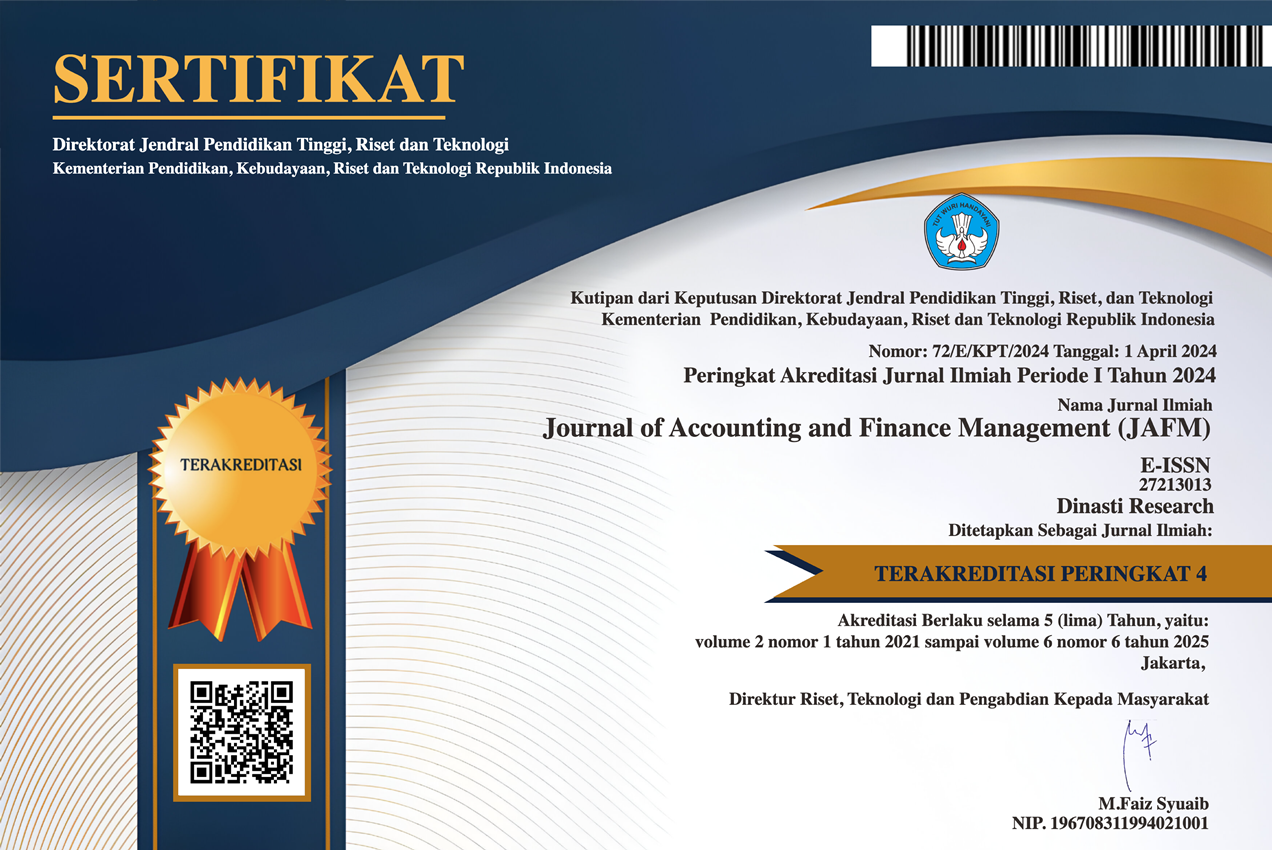Determinants of the Discount for Lack of Marketability in Business Valuation: Evidence from Indonesia
DOI:
https://doi.org/10.38035/jafm.v6i4.2492Keywords:
Discount for Lack of Marketability, DLOM, Restricted Stock StudyAbstract
The study intends to identify the determinants of the discount for lack of marketability or DLOM in the Indonesia Stock Exchange. Significant variables are then used to compare high, medium, and low categories of DLOM. The results of this comparison can be used as a basis for calculating this discount in a business valuation in Indonesia. The samples in this study are companies that announced seasoned equity offerings on the market between 2013-2022 through the IDX website, the Reuters database, and the issuer's prospectus. The multiple discriminant analysis shows five significant variables: the percentage of cash to the value of market capitalization, volatility, buyers type, the ratio of EBITDA to the book value of assets, and the ratio of debt to the equity. The result is obtained from the analysis using the restricted stock study. This study uses the theory of asymmetric information and strong-form efficient markets in forming stock prices, to explain the emergence of DLOM.
References
Akerlof, G. A., 1970. “The Market for “Lemons”: Quality Uncertainty and the Market Mechanism.” The Quarterly Journal of Economics, Volume 84, Issue 3, August 1970, Pages 488–500.
Albart, N., Sinaga, B. M., Santosa, P. W., dan Andati T. 2020. “The Effect of Corporate Characteristics on Capital Structure in Indonesia.” Journal of Economics, Business, and Accountancy Ventura 23(1), pp.46-56.
Azis, I. J. 2022. “Indonesia, a Tale of Three Crises.” Diakses pada 20 Oktober 2022. http://iwanazis.com/papers-2022.
Bruner, R. F., dan Palacios, M. 2004. “Valuing Control and Marketability.” Batten Institute. Diakses pada 18 Agustus 2023. https://ssrn.com/abstract=553562.
Chaffe III, D. B. 1993. “Option Pricing as a Proxy for Discount for Lack of Marketability in Private Company Valuations.” Business Valuation Review 12 (4), pp. 182–188.
Chuang, K. S. 2019. “Private Placements, Market Discounts and Firm Performance: The Perspective of Corporate Life Cycle Analysis.” Review of Quantitative Finance and Accounting, 54(2), pp.541-564.
Comment, R. 2012. “Revisiting the Illiquidity Discount for Private Companies: A New (and “Skeptical”) Restricted-Stock Study.” Journal of Applied Corporate Finance, 24(1), pp. 80-91.
Daryaei, A. A., dan Fattahi, Y. 2022, “Stock Liquidity and Stock Return: An Asymmetric Impact of Institutional Ownership Approach.” Corporate Governance: The International Journal of Business in Society, 22(4), pp.781-797.
Downing, C., Jaffee, D., dan Wallace, N. 2009. “Is the Market for Mortgage–Backed Securities a Market for Lemons?” Review of Financial Studies, 22(7), 2457–2494.
Fama, E. F. 1960. “Efficient market hypothesis.” Disertasi doktoral. University of Chicago, Graduate School of Business.
Harris, A., dan Raviv. 1991. “The Theory of Capital Structure.” The Journal of Finance, 46 (1) (1991), pp. 297-355.
Harris, W. 2009. ‘Trugman Valuation Associates, Inc. Restricted Stock Study.” Business Valuation Review, Fall 2009: 128-139.
Hertzel, M., dan Smith, R. L. 1993. “Market Discounts and Shareholder Gains for Placing Equity Privately.” The Journal of Finance 48, p. 459-485.
Huson, M. R., Malatesta, P. H., dan Parrino, R. 2009. “The Decline in the Cost of Private Placements.” In AFA 2010 Atlanta Meetings Paper.
IDX Monthly Statistics, Oktober 2020. Diakses pada 2 Februari 2023. https://www.idx.co.id/id/data-pasar/laporan-statistik/statistik.
Institutional Investor Study Report of the Securities and Exchange Commission. 1971. Discounts involved in purchases of common stock. H.R. Doc. No. 64 Part 5, 92 nd Congree, 1st Session, 1971, pp. 2444-56.
Jensen, M. C. 1986. “Agency Costs of Free Cash Flow, Corporate Finance and Takeovers.” American Economic Review, 76(1986), p. 323-329.
Judijanto, Loso. 2024. “Menilai Evolusi Teknik Penilaian Bisnis: Analisis Bibliometrik” Sanskara Manajemen dan Bisnis, Vol. 3, No. 01, November, pp. 21-32.
Kau, J. B., Keenan, D. C., Lyubimov, C., dan Slawson V.C., 2012. “Asymmetric Information in the Subprime Mortgage Market.” J Real Estate Finan Econ 44, p. 67–89.
Koller, T., Goedhart, M., dan Wessels, D., 2010. “Valuation: Measuring and Managing the Value of Companies.” John Wiley & Sons.
Longstaff F.A. 1995. “How Much can Marketability Affect Security Values?” The Journal of Finance, 50(5), pp.1767-1774.
McConaughy D. L. dan Covrig V. 2015. “Public Versus Private Market Participants and the Prices Paid for Private Companies.” De Gruyter, Journal of Business Valuation and Economic Loss Analysis, 10(1), p. 77–97.
McConaughy, D. L., Hussein, M., dan Dow Jr, J. P. 2018. “Restricted Stock Discounts: An Empirical Analysis.” Journal of Business Valuation and Economic Loss Analysis, 14(1), p. 20170008.
Miller, M. H. dan Modigliani, F. 1961. “Dividend Policy, Growth and the Valuation of Shares.” Journal of Business, 34, p. 411-33.
Modigliani F. dan Miller M. 1963. “Corporate Income Taxes and the Cost of Capital: A Correction.” American Economic Review, 53, p. 433-443.
Modigliani, F. dan Miller, M. 1958. “The Cost of Capital, Corporation Finance, and the Theory of Investment.” American Economic Review 53.
Myers, S. C., dan Majluf, N. S. 1984. “Corporate Financing and Investment Decisions When Firms Have Information that Investors Do Not Have.” Journal of Financial Economics 13(2), pp. 187-221.
Opler, T., Pinkowitz, L., Stulz, R., dan Williamson, R. 1999. “The Determinants and Implications of Corporate Cash Holding.” Journal of Financial Economics. 52(1999), p. 3-46.
Pittock, William F., dan Charles H. S. 1983. “Revenue Ruling 77·276 Revisited.” SRC Quarterly Reports, Spring 1983, pp. 1-3.
Sansing, R. C. 1999. “Economic Foundations of Valuation Discounts.” The Journal of the American Taxation Association, 21 (Supplement), 28-37.
Stewart, B. 2019. “EVA, not EBITDA: A New Financial Paradigm for Private Equity Firms.” Journal of Applied Corporate Finance, 31(3), pp.103-115.
Wruck, K. H. 1989. “Equity Ownership Concentration and Firm Value: Evidence from Private Equity Financings.” Journal of Financial Economics 23, 3p. -28.
Downloads
Published
How to Cite
Issue
Section
License
Copyright (c) 2025 Tarsisius Catur Budi Nugraha, Sri Wahyuni

This work is licensed under a Creative Commons Attribution 4.0 International License.
Authors who publish their manuscripts in this journal agree to the following conditions:
- The copyright on each article belongs to the author(s).
- The author acknowledges that the Journal of Accounting and Finance Management (JAFM) has the right to be the first to publish with a Creative Commons Attribution 4.0 International license (Attribution 4.0 International (CC BY 4.0).
- Authors can submit articles separately, arrange for the non-exclusive distribution of manuscripts that have been published in this journal into other versions (e.g., sent to the author's institutional repository, publication into books, etc.), by acknowledging that the manuscript has been published for the first time in the Journal of Accounting and Finance Management (JAFM).
























